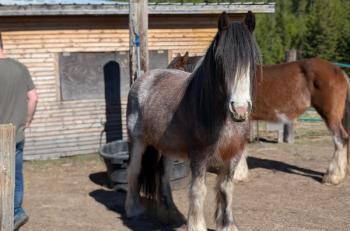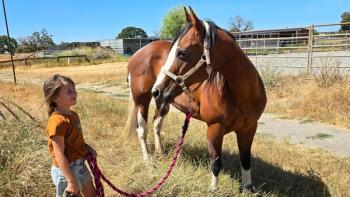
EPM: including updated diagnostics (Proceedings)
Equine protozoal myeloencephalitis (EPM) is a common neurological disease of horses in the Americas. Horses with EPM most commonly have abnormalities of gait but also may present with signs of brain disease.
Equine protozoal myeloencephalitis (EPM) is a common neurological disease of horses in the Americas. Horses with EPM most commonly have abnormalities of gait but also may present with signs of brain disease. The disease ranges in severity from mild lameness to sudden recumbency and clinical signs usually are progressive. A causative agent, Sarcocystis neurona, has been isolated from affected horses and serologic surveys suggest that upwards of 50% of horses in endemic sections of the US have been infected with this agent. EPM is considered a treatable disease although the response often is incomplete.
History and distribution
The disease was first recognized in the US in 1964 (reported in 1970), and possibly earlier in Brazil. Since 1970, EPM has been reported in horses from most of the contiguous 48 states, Panama, Canada and Brazil, and there have been unpublished reports of the occurrence of the disease in Venezuela, Colombia, Argentina, and Mexico. The majority of affected horses are 1-5 years old, but older horses commonly also are affected. Although EPM has allegedly been confirmed in a 2-month-old, the disease is almost unknown in suckling foals. Prevalence of EPM by breed and gender is close to that in the general horse population; however, Standardbreds and males were over-represented in two published surveys. EPM also has been reported in a pony.
Causative agent(s)
Protozoa may be found in any part of the CNS, usually in association with mixed inflammatory cellular response and neuronal destruction. Schizonts (a proliferating form of the organism), in various stages of maturation, or free merozoites are seen commonly in the cytoplasm of neurons or mononuclear phagocytes and rarely in other inflammatory or CNS cells. The parasite is in the order Apicomplexa, which includes the family Sarcocystidae. In 1991, protozoa from the spinal cord of a horse from New York state were isolated in continuous culture in a bovine monocyte cell line and named S. neurona. Since then, many additional isolates have been obtained in monocyte or endothelial cell culture from horses throughout the country (including UF). A few cases of EPM in the Americas have been associated with Neospora hughesi. Serologic surveys of horses have suggested an exposure rate to Neospora spp. of 10-25%.
Life cycle
Species of Sarcocystis have an obligatory prey-predator two-host life cycle. The genus is named for the terminal developmental stage (sarcocyst) found in the intermediate host. The sarcocyst is the only developmental stage that is infectious for the definitive host. Because S. neurona sarcocysts have been found in only one horse (a foal), it is assumed that the horse is usually an aberrant dead-end host. Ingestion of sarcocysts by the appropriate flesh-eating (i.e., predator or scavenger) definitive host results in invasion of the small intestinal epithelium and sexual proliferation and differentiation to produce oocysts. The oocysts of Sarcocystis each contain two sporocysts which usually are released from thin-walled oocysts before they are passed with feces. Sporocysts are immediately infectious for the intermediate host. They are quite persistent in the environment and may survive for months, even during extremes of heat and cold. Intermediate hosts are infected by ingestion of contaminated feed or water.
Opossums (Didelphis virginiana in the US) has been identified as the definitive host. Several intermediate hosts including the 9-banded armadillo (Dasypus novemcinctus), the striped skunk (Mephitis mephitis), and the raccoon (Prylon locor) have been identified. Their combined geographic range covers the area where EPM occurs. The domestic cat also can support the life cycle in nature although its importance in maintaining the life cycle is unclear. Several other hosts of dubious significance, including the Pacific Harbor seal, the California sea otter, the domestic dog, and farmed mink, have also been identified. It should be noted that S. neurona has been responsible for significant die-offs of sea otters during the last decade. By epidemiologic techniques, S. neurona has been shown to expand clonally be self-mating in opossums. The possibility also has been raised that the organism may be transmissible between carnivorous intermediate hosts, as routinely happens in the closely related Toxoplasma gondii. The hosts for N. hughesi are not known.
Diagnosis and epidemiology:
Definitive ante-mortem diagnosis of EPM is not possible. Proof of diagnosis post-mortem is demonstration of merozoites, S. neurona antigen, or nucleic acid in CNS lesions. The diagnosis frequently is made presumptively even when the organism is not seen if characteristic inflammatory changes are found.
Antibody tests
• The Western Blot assay for S. neurona antibody is the most long-standing diagnostic test for EPM. Serums are tested for reactivity with specific bands in transferred SDS-electrophoretograms of S neurona lysate. Recognition of these bands is taken as indication of previous or current exposure to S neurona. Results are reported as positive, weak positive, non-specific, or negative. Large serologic surveys from many states generally have shown overall seropositive rates of 25 - 65% of horses tested. Reportedly, no neonatal presuckle serum has tested positive by Western Blot; however, foals frequently become seropositive after ingestion of colostrum. Once horses seroconvert, they probably remain seropositive for months to years. Sensitivity is high (>90%) but specificity is low. On the basis of these results, a negative serum test is useful to help rule out EPM (i.e., false-negative results are uncommon) but has little value in confirming the disease (false-positive results are very common).
Compared to the serum test, Western Blot testing of undiluted CSF has somewhat better specificity for EPM although there remains a problem with false-positive results. An important cause for false-positive Western Blot results in CSF samples is contamination by serum S. neurona antibody. Serum proteins may enter CSF (1) normal filtration of serum IgG into the CSF; (2) as a result of disruption of the blood-CNS barrier (e.g., West Nile encephalomyelitis, trauma); (3) by accidental blood contamination during CSF collection. Clearly, when the S. neurona antibody titer in plasma is high false-positive results will still result from normal filtration or blood contamination during collection. A useful additional test routinely performed by one of the commercial laboratories is the Relative Quantity CSF (RQC). This tests quantifies the amount of CSF antibody directed against an important antigen on S. neurona. Values <5 suggest low-level or doubtful infection of the CNS, whereas values >5 (5-100) are likely true positives. Notwithstanding the problems outlined above, the CSF Western Blot, when used in horses that do have abnormal neurologic signs is still a useful diagnostic test for EPM but has largely been supplanted by the serum:CSF ratio test (see below).
A useful additional test routinely performed by one of the commercial laboratories is the Relative Quantity CSF (RQC). This tests quantifies the amount of CSF antibody directed against an important antigen on S. neurona. Values <5 suggest low-level or doubtful infection of the CNS, whereas values >5 (5-100) are likely true positives. The RQC also can be used as a treatment guide (see below).
• b. Immunofluorescent antibody test. An IFAT test for use with serum and CSF samples has been developed at the University of California, Davis, that shows good sensitivity and specificity when tested against a small panel of "gold standard" negatives and positives. The requirement for blood rather than CSF certainly elevates the utility of this test, but serious doubts must remain for any test that uses a blood titer to identify the less than 1 in 100 infected/exposed horses that have clinical disease.
• c. snSAG-1 ELISA titer. This is test that is usually run on blood and yields a titer that can be compared with test guidelines. Although this test accurately quantifies a response against an immunodominant surface antigen it suffers from 2 major drawbacks: first, it is a blood test (see IFAT) and, second, many of the S. neurona isolates so far isolated don't express this antigen.
• d. snSAG-2,4/3 ELISA serum:CSF ratio test. This test has been available since late 2010 and shows great promise as an assay that not only has high sensitivity for EPM diagnosis (like the tests above) but also is highly specific. Use of the serum:CSF ratio accounts for the filtered fraction of serum IgG and identifies the fraction produced within the CNS. In this way, the test appears to be able to distinguish "exposed" healthy horses from those with EPM. Horses with ratios >100 are read as negative, those <100 are positive for EPM, and those exactly 100 are in a difficult grey area. This is the best test currently available but requires that both spinal fluid and blood are submitted for testing.
Polymerase Chain Reaction (PCR).
Experience with the test indicates that, when used alone as a test for EPM, it has low sensitivity and high specificity (close to 100%). In the last 5 years, this test has fallen into disuse because of technical concerns about the way the test is run.
Ancillary aids to diagnosis
There are abnormalities upon CSF analysis in some horses with EPM. It has been reported that as many as 35% of horses at a referral hospital have increased protein concentration (>65 mg/dL) or nucleated cell count (>6 cells/μL). My experience is that, among horses with mild clinical signs of EPM (i.e., those that typically are encountered in practice), a very low percentage have any abnormality on routine analysis. Creatine kinase (CK) activity may be high in CSF, reflecting diffusion of BB isoenzyme from damaged CNS gray matter. Unfortunately, inadvertent inclusion of a small plug of epidural fat or dura during CSF collection can dramatically elevate CK activity, thus reducing the specificity of the test.
Clinical signs
Because protozoa may infect any part of the CNS, almost any neurologic sign is possible. The disease usually begins insidiously but also may present acutely and be severe at onset. Signs of spinal cord involvement are seen more commonly (at least >95%) than signs of brain disease.
Horses with EPM involving the spinal cord have asymmetric or symmetric (rarely) truncal and limb weakness and ataxia. If all lesions are behind the second thoracic spinal cord segment (T2), only the hindlimbs are affected. If a lesion (or lesions) is located in front of T3, all four limbs may be affected. When the spinal cord behind the second sacral spinal cord segment (S2) is involved, there are signs of cauda equina syndrome, which may include degrees of rectal, anal, bladder, and penile paralysis and hypalgesia of the skin of the tail and perineum. If gray matter is damaged for more than 1-2 weeks, there may be obvious skeletal muscle atrophy (usually asymmetric) and electromyographic evidence of denervation. Common locations for atrophy in horses with EPM are gluteals, biceps femoris, infraspinatus/supraspinatus and serratus ventralis. EPM lesions in the spinal cord also may result in demarcated areas of spontaneous sweating or loss of reflexes and cutaneous sensation. Signs noticed at the walk or during neurologic exam include any to all of the following: pelvic sway and swivel, asymmetric stride length, toe-dragging, circumduction of hindlimbs, and dysmetria. More subtle signs include difficulty with flying lead changes or maintenance of specific leads. Some signs which usually are attributed to primary musculoskeletal disease, such as back soreness or upward fixation of the patella(s) can be caused by weak or asymmetric use of muscle groups in horses with EPM that are in training.
The most common manifestation of brain disease in horses with EPM is a brainstem syndrome with obtundation and asymmetric vestibular (VIII) nerve dysfunction. There may also be facial paralysis (VII), dysphagia (IX, X), tongue paralysis (XII), laryngeal paralysis (X), strabismus (III, IV, VI), corneal areflexia (VI) and weak jaw tone (V). With involvement of the rostral brainstem and/or cerebrum, EPM may manifest as seizures, visual deficit/abnormal menace response, and behavioral abnormality.
Without treatment, EPM usually progresses. Progression to recumbency occurs over hours to years and may occur steadily or in a stop-start manner.
Treatment
The conventional protocols for antiprotozoal therapy involve a combination of sulfadiazine and pyrimethamine given orally. These agents act synergistically to inhibit protozoal folate synthesis. Because pyrimethamine also has slight inhibitory activity for mammalian dihydrofolate reductase, there is potential for inhibition of hematopoiesis and other toxic side-effects in treated horses. An affordable FDA-approved sulfadiazine/pyrimethamine suspension (ReBalance™; Phoenix Scientific, St. Louis, MO) became available early in the last decade but has been withdrawn from the market. Compounded suspensions and pastes are offered by numerous compounding pharmaciesusually at highly discounted rates. A single oral dose is given once daily by syringe. Because feeding, especially of alfalfa hay, has been shown to reduce absorption of pyrimethamine by up to 50%, it is suggested that treatment is given at least an hour after and before hay is fed. Currently, it is recommended that horses with EPM are treated with sulfonamide/pyrimethamine for 3 to 6 months.
An anti-coccidial of the triazine family, ponazuril was the first drug to win FDA approval for use in EPM. The drug is given as a dial-by-weight paste at 5 mg/kg for 28 days. Toltrazuril, which is very closely related to ponazuril, is currently a black-market drug but is used frequently by racehorse handlers. In 2003, the 5-nitrothiazole drug, nitazoxanide also was approved by the FDA but was withdrawn from the market in 2008. A benzeneacetonitrile antiprotozoal diclazuril also received FDA approval almost a decade ago and is about to be introduced as a commercial product. This product will be unique in the field in that it is to be formulated as an alfafa pellet to be topdressed on feed. The efficacy/toxicity profile of diclazuril should be very similar to those for ponazuril. A highly bioavailable Na salt of diclazuril is used by some veterinarians, as is an intravenous prepartion; however, these are not approved drugs.
Approximately 55-70% of horses improve with any of these regimens, and 10-20% can be considered complete recoveries. If treatment is discontinued at that point, relapses may occur over the next several years in at least 10% of treated horses. Treatment of horses that relapse usually is less successful than treatment of initial disease.
Mild to moderate anemia (PCV 20%) is rarely seen in horses given SDZ/PYR for 6 months. Anemia resolves within several weeks after drugs are discontinued. Neutropenia and thrombocytopenia also occasionally have been observed in treated horses. There have been isolated instances of abortions and neonatal disorders after treatment of pregnant mares, although a causal relation has not been established. Despite a theoretical concern about the fertility of stallions treated with EPM, no adverse effect has been documented. In human beings, folinic acid (5-formyl-THF), a form of bioactive tetrahydrofolate, is given to prevent or treat toxic effects of pyrimethamine. Preformed folate cannot be used by protozoa, so this practice has no effect on antimicrobial efficacy. Folic acid (the substrate of DHFR) is sometimes given to horses in an effort to prevent toxicity but on theoretical grounds probably has no positive effect and may actually be deleterious. Of far greater value is the provision of good quality folate-rich pasture or alfalfa hay. If the PCV drops below 20% or there is severe neutropenia or thrombocytopenia, antimicrobial treatment may be discontinued for 1-2 weeks until hematologic values return to an acceptable range. Signs of toxicity are very rare with ponazuril or diclazuril treatment; however, severe colitis, fevers, and depression were seen in some horses treated with nitazoxanide. It is widely assumed that these signs occur secondary to clostridial overgrowth in the large intestine.
If neurologic signs are severe or rapidly progressive, anti-inflammatory/anti-oxidant therapy should be used for several days during the initial period of antimicrobial therapy or during any period of exacerbation. "Loading" doses of ponazuril (3 to 7x normal dose for 1 to 3 days) may be given off-label to rapidly move steady-state concentrations of the drug into a theoretically effective range. A reasonable protocol is flunixin meglumine (1.1 mg/kg IV), and flunixin once daily for 4 days. Natural vitamin E should be begun orally at the rate of 20 IU/kg/day. When signs of brain disease are severe or the horse is in danger of becoming recumbent at onset of therapy, a single to several doses of corticosteroid (e.g., dexamethasone, 0.05-0.1 mg/kg) is justified..
Some clinicians attempt to boost cell-mediated immunity by use of immunostimulants such as killed Propionibacterium acne (Eqstim), killed parapox ovis virus (Zylexis), mycobacterial cell wall extract (Equimune IV), levamisole, or alpha interferon. In persistent protozoal diseases of human beings, such as leishmaniasis, the efficacy of such approaches is established.
Prevention
It is presumed that horses ingest infective opossum sporocysts with feed or water. Opossums are omnivores, and are attracted to grains, moist or dry cat or dog food, fruit or garbage. Therefore, horse feed and pet food should not be left out and open feed bags and garbage should be kept in closed galvanized metal containers, bird-feeders should be eliminated, and fallen fruit should be removed. Opossums can be trapped and relocated or scared off by a patrolling big black dog or a herd of Jack Russells. Less practically, paddocks can be opossum-proofed by placing a partially buried 2-in × 4-in-mesh fence and electric wire on the outside of existing horse fence. It is probable that sporocysts are distributed from the point of deposition by birds and/or insects, so it may be prudent to control populations of these potential vectors, at least within horse barns. Steam cleaning has been shown to kill sporocysts, so feed and water containers could be cleaned by this technique. An issue which hasn't been addressed is the possibility of contamination of commercially prepared feeds with S. neurona sporocysts. Because they have been heated (60 - 166 C) during preparation, "hot-processed" feeds (e.g., steam flaked, pelleted, or extruded feeds) are unlikely to harbor viable sporocysts. Because intermediate hosts do not directly infect horses, control of intermediate host populations is unlikely to be effective.
An EPM vaccine was sold under limited license for several years. The notably simplistic approach to vaccine development, i.e., use of killed cultured whole organisms, was criticized and the vaccine was withdrawn in 2007.
Newsletter
From exam room tips to practice management insights, get trusted veterinary news delivered straight to your inbox—subscribe to dvm360.






